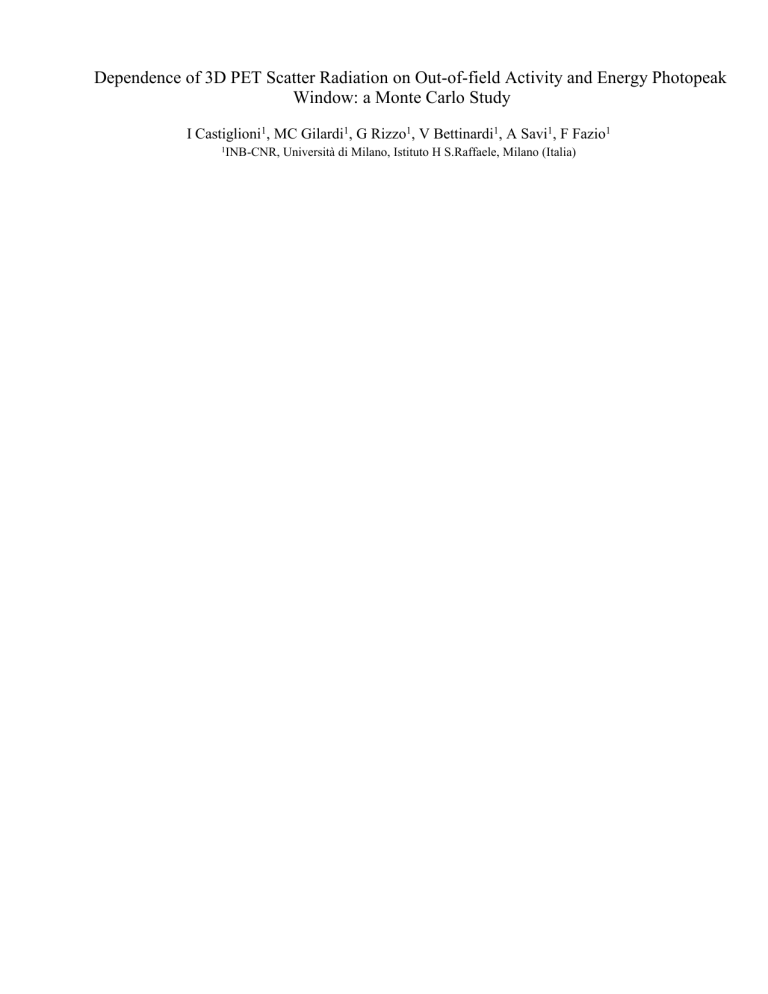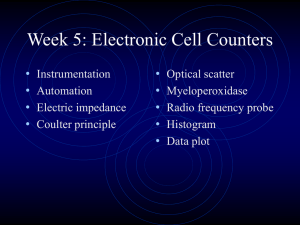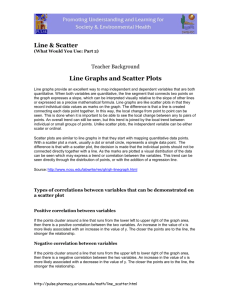ConfTNS-1c: Instructions for Authors of Papers Submitted for

Dependence of 3D PET Scatter Radiation on Out-of-field Activity and Energy Photopeak
Window: a Monte Carlo Study
I Castiglioni
1
, MC Gilardi
1
, G Rizzo
1
, V Bettinardi
1
, A Savi
1
, F Fazio
1
1 INB-CNR, Università di Milano, Istituto H S.Raffaele, Milano (Italia)
Abstract
Aim of this work was to assess the dependence of 3D PET scatter radiation on out-of-field activity and media (OFAM) and on the selected discrimination energy photopeak window
(EPW). For this purpose, a Monte Carlo software package, dedicated to the simulation of realistic 3D PET clinical studies, was used. Energy and spatial distributions were simulated in the case of brain phantoms and clinical studies.
The results of this work prove that: a) up to 20% of the detected scatter component in a 3D PET brain study originates from OFAM; b) 98% of such scatter contribution originates from OFAM extending one axail field-of-view beyond the scanner edge; c) the shape of scatter spatial distribution is weakly dependent on EPW; d) when changing EPW from 300-
650keV to 400-750keV, SF decreases from about 30% to about 19%, with a corresponding significant increase of Noise
Effective Sensitivity.
I.
I
NTRODUCTION
The detection of scatter radiation represents one of the major sources of error in 3D PET. In order to implement accurate scatter correction techniques, many studies have been dedicated to the analysis of scatter component in various experimental conditions, both in terms of amount of scatter detected and in terms of scatter spatial distribution [1-3].
Although PET scanners are equipped with external shields and although scattered radiation can be partially rejected by setting discrimination energy photopeak windows (EPW), the contribution of scattered radiation originated from out-of-field activity and media (OFAM) has been found to be not negligible, particularly for PET scanners with large axial field of view [4-5].
The effects of OFAM scatter contribution to PET data is hard to be evaluated by experimental studies [6], while a powerful tool for such investigation is offered by Monte Carlo methods, which allow independent simulation of scatter and unscatter distributions. This approach takes advantage of the current availability of Monte Carlo software packages allowing simulation of complex and realistic radioactive sources [7-9]
In this work, a Monte Carlo software package, dedicated to the simulation of 3D PET clinical studies [9], was used to investigate the dependence of 3D PET scatter radiation on
OFAM and EPW in brain–like phantom and clinical studies.
II. M
ATERIALS AND
M
ETHODS studies are considered as input source, OFAM can be accounted for by Monte Carlo simulations. PET-EGS allows simulated data to be sorted by energy, to create energy spectra, and by detection location, to create spatial distributions
(sinograms). Independent scatter, unscatter, total (scatter + unscatter) sinograms can be created, according to selected discrimination EPWs.
B. The PET system
Experimental measurements were performed using the 3D
PET scanner GE-Advance [10].
The tomograph consists of 18 rings of BGO crystals
(d=92.7cm, 672 crystals/ring, 4x8.1x30 mm 3 crystal size). The detection unit is a matrix of 6x6 crystals coupled to two dual photomultipliers. Axial and transaxial field-of-view (FOV) are
15.2cm and 55cm respectively. The system is equipped with two external septa (W, R in
=36.5cm, R ext
=59.5cm) to shield the detection of scatter and random radiation due to OFAM. A default EPW at 300-650 keV is set to reduce the detection of scatter radiation. In the conventional bi-dimensional (2D) acquisition mode, 35 planes (18 direct and 17 cross) can be defined in two different configurations, privileging High
Resolution in the axial direction (HR) or High Sensitivity (HS) respectively. In the 3D mode, all possible coincidences may be recorded over 18x18 acquisition planes.
C. Phantom and clinical studies
Uniform cylinder (UC)
A cylinder (d=20cm, l=19 cm,), filled with an homogeneous 18 F water solution (18kBq/cc), was studied by
3D PET and simulated by PET-EGS as an analytical source. In order to assess the effect OFAM, simulations were also performed for different axial lengths of the cylinder:
L1=15.2cm=1 FOV (phantom axially centered in the scanner
FOV), L2 = 2 FOVs (phantom extending 1 FOV outside the scanner edge), L3 = 3 FOVs (phantom extending 2 FOVs outside the scanner edge in one direction).
Line source in water cylinder (LS)
A 18 F line source in a water cylinder (d=20cm, l=19cm), 8 cm off-centre, was studied by 3D PET and simulated as an analytical line in a water cylinder. Simulations were repeated for different axial lengths of the phantom, as described for UC:
L1=1 FOV, L2 = 2 FOVs, L3 = 3 FOVs.
Brain study
A 2D multi-volume 18 FDG PET study was performed at three contiguous bed positions, from head to thorax (three volumes, 5min/position). A 10 min 3D PET study was recorded at the first bed position. TR scans were performed.
Transmission and 2D Emission PET images were assumed as input voxelised source objects for simulations.
A. The Monte Carlo Simulator PET-EGS
The Monte Carlo software package PET-EGS [9] was used to simulate the detection of scattered radiation in representative phantom and clinical studies performed by a current generation 3D PET scanner.
PET-EGS simulates simple and complex radioactive sources, described by analytical functions or voxelised objects.
Realistic clinical studies can be simulated assuming emission and transmission PET studies to describe the source/media distribution in the source object. When multiple-volume PET
D. Data Analysis
For each simulated source with different axial length, data were analysed as follows:
Energy spectra
Coincidence energy spectra were generated by summing events from all crystals in a ring (one coincidence energy spectrum/ring).
Scatter fractions (SF) were calculated from the simulated energy spectra as the ratio between scatter and total events: a) over the whole spectrum (no EPW selected), b) for the default energy window for the GE-Advance scanner (EPW = 300-
650keV); c) for an additional EPW located higher in the energy spectrum (EPW = 400-750keV).
Noise effective sensitivity (NES) were calculated for
EPW=300-650keV and for EPW=400-750keV:
NES = (1 – SF)
being the unscatter sensitivity.
Spatial distributions
For all sources, representative spatial distribution profiles were derived from measured sinograms by summing HS sinograms, extracted from the 3D measured data set, and averaging over all angular projections. Representative spatial distribution profiles were similarly obtained from simulated data in the experimental configuration (EPW=300-650keV,
L=19cm for UC and LS, L=30.4cm corresponding to two volumes for the brain study).
Dependence on OFAM
The dependence of the response of the scanner on the detection of scatter originated from OFAM was assessed by comparing SF for the various considered sources as a function of OFAM.
Dependence on EPW
The dependence of the response of the scanner on the selected
EPW was assessed by comparing SF and NES for the various considered sources as a function of EPW.
Table 3.
Scatter fraction (SF) (EPW = 400-750 keV)
0
SF (%)
1 FOV 2 FOVs
UC
LS
17.91
0.05 20.98
0.04 21.4
0.03
16.08
0.07 18.02
0.05 19.3
0.05
Brain study 17.10
0.03 19.83
0.08 20.01
0.08
In all configurations, the considered sources have comparable SF values, as a result of the similar brain-like geometry.
For all sources, as expected, SF increases with OFAM extension. An increment of 15-20% in the detected scatter component is found when considering OFAM extending 2
FOVs beyond the scanner edge. However, 98% of this component is due to scatter radiation originated from OFAM extending only 1 FOV.
Fig.1 shows, as an example in the case of the brain study, the axial dependence of SF values estimated over the whole energy spectrum for the different OFAM extensions. SF is quite constant in the axial dimension, with a decrease at the most external planes (possibly due to the presence of the external septa). From Fig.1, it can also be noted the almost negligible scatter contribution from OFAM extending 2 FOVs
(overlapping between red and green lines), except in the external planes on the side of OFAM (SF difference up to 5% in first four planes).
Fig.2 shows, as an example for the brain study, the simulated coincidence energy spectrum obtained when considering 0, 1, 2 FOVs OFAM extensions. Total (scatter + unscatter) and scatter distributions are shown in fig.2 upper and bottom respectively.
IV.
R
ESULTS
Dependence on OFAM
SF values (averaged over detection rings) are reported in
Tables 1-3 as a function of OFAM extension considered for simulations, for the selected EPWs.
Table 1.
Scatter fraction (SF) (no EPWs selected)
0
SF (%)
1 FOV 2 FOVs
UC 53.21
0.03 60.52
0.02 61.13
0.02
LS 42.18
0.01 48.90
0.02 50.62
0.03
Brain study 49.81
0.04 57.72
0.03 58.23
0.02
Table 2.
Scatter fraction (SF) (EPW = 300-650 keV)
0
SF (%)
1 FOV 2 FOVs
UC 30.44
0.04 33.76
0.03 34.62
0.03
LS 27.18
0.05 29.22
0.06 31.01
0.05
Brain study 29.30
0.04 31.62
0.06 32.18
0.07
Titolo:
Fig1.eps
Aut ore:
MATLAB, The Mathw orks , Inc .
Ant eprima:
L'immagine EPS non è s tat a s alvata con l'anteprima inc lusa in ess a.
Commento:
L'immagine EPS potrà es sere s tampata con una s tampante
Post Script e non c on altri tipi di s tampante.
Fig.1.Brain study. Axial dependence of SF (no EPW selected: no
OFAM (blue line), OFAM extending 1 FOV beyond the scanner edge (red line), OFAM extending 2 FOVs beyond the scanner edge
(green line).
Titolo:
Fig2b.eps
Autore:
MATLAB, The Mathw orks, Inc.
Anteprima:
L'immagine EPS non è s tata salv ata c on l'anteprima inc lusa in ess a.
Commento:
L'immagine EPS potrà es sere stampata con una s tampante
Pos tSc ript e non con altri tipi di s tampante.
Table 4 summarises the values of the NES ratio in EPW=400-
750keV and EPW=300-650keV, for the considered sources, showing a consistent improvement on the order of 10-20%.
Table 4.
NES ratio in EPW =400-750keV and EPW=300-650keV
UC
LS
Brain study
0
1.18
1.13
1.15
NES ratio
1 FOV
1.15
1.11
1.12
2 FOVs
1.16
1.10
1.12
Fig.4 shows, as an example in the case of the Brain study, the simulated total and scatter spatial distributions (OFAM extending 1FOV) relative to the whole energy spectrum (no
EPW), to EPW=300-650 keV and to EPW=400-750 keV.
Titolo:
Fig2a.eps
Autore:
MATLAB, The Mathw orks, Inc.
Anteprima:
L'immagine EPS non è s tata salv ata c on l'anteprima inc lusa in ess a.
Commento:
L'immagine EPS potrà es sere stampata con una s tampante
Pos tSc ript e non con altri tipi di s tampante.
Fig.2. Brain study. (Upper) total (unscatter + scatter) and (bottom) scatter coincidence energy spectra: no OFAM (blue), OFAM extending 1 FOV beyond the scanner axial FOV (red), OFAM extending 2 FOV beyond the scanner axial FOV (green).
The increase of scatter contribution, when OFAM is considered, can be observed, confirming the previous results.
A shift towards the lower part of the Compton spectrum can be noted for OFAM increasing extensions, indicating a higher contribution of multiple and large angle scatter coincidences.
Fig.3 shows, as an example in the case of the Brain study, the comparison between the measured spatial profile and the simulated total profile (OFAM extending 1FOV, EPW=300-
650keV). The good agreement, observed qualitatively in Fig.3 was confirmed by a statistical analysis ( 2 test, p>0.95), proving that most scatter radiation is simulated by accounting for OFAM extending 1 FOV beyond the scanner edge.
Fig.3. Brain study. Simulated total (- -) and measured (-) profiles
Dependence on EPW
The dependence of SF on the selected energy window can be derived comparing SF values in Tables 1-3. In particular,
SF decreases by a factor of 1.6, when changing EPW from
300-650keV to 400-750keV (e.g. in the case of the Brain study, from 32% to 20%).
Fig.4. Brain study. Total and scatter distributions (OFAM extending
1 FOV beyond the scanner edge): no EPW selected (..), EPW=300-
650 keV (--) and EPW=400-750 keV (-).
Scatter distribution, showing a smooth low frequency pattern, is weakly dependent on the EPW position. The choose of the higher EPW=400-750 keV results in both a decreased scatter and increased unscatter component, confirming the results in terms of NES.
V.
CONCLUSIONS
The results of this work in brain-like studies prove that: a) up to 20% of the detected scatter component in a 3D
PET brain study originates from OFAM; b) 98% of such scatter contribution originates from
OFAM extending 1 FOV beyond the scanner edge; c) the shape of scatter spatial distribution is weakly dependent on EPW; d) when changing EPW from 300-650 keV to 400-750 keV, SF decreases from 30% to 19%, with a corresponding significant increase of NES.
In conclusion, OFAM contribution cannot be neglected by scatter correction techniques. The choose of high EPW can improve the response of a 3D PET scanner.
VI.
REFERENCES
[1] J.S.Barney et al, “Object Shape Dependent Scatter
Simulation for PET”, IEEE NS, vol.38, pp.719-725, 1991
[2] C.Moisan et al, “A Monte Carlo study of the acceptance to scattered events in a Depth Encoding PET camera,
IEEE NS, vol.43, pp.1974-1980, 1996
[3] S.R.Cherry and S.C.Huang, “Effects of scatter on model parameters estimates in 3D PET studies of the human brain”, IEEE-NS, vol.42, pp.1174-1179
[4] T.K.Lewellen et al, “ Effect of Lower Energy Threshold on Single and Multiple Scatter Distributions in Positron
Volume Imaging”, in IEEE NSS and MIC, Toronto,
Canada, 1998 (in press)
[5] L.-E.Adam et al, “ Monte Carlo simulation of the scatter contribution in a 3D Whole-Body PET”, in IEEE NSS and MIC, Toronto, Canada, 1998 (in press)
[6] V.Sossi et al. ”Effect of Scatter from Radioactivity Outside the Field of View in 3D PET”, IEEE MIC, pp.1614-1617,
1994
[7] R.L.Harrison et al, “Preliminary experience with the photon history generator module of a public domain simulation system for emission tomography”,
Conf.Rec.Nucl.Sci.Symp., vol.2, pp.1154-1158, 1993
[8] C.S.Levin et al, “A Monte Carlo correction for the effect of Compton scattering in 3-D PET brain imaging”, IEEE-
NS, vol.42, pp.1181-1185, 1985
[9] E.Bellotti et al, “3D Positron Emission Tomography: a
Monte Carlo study of scattered radiation”, INFN T.C.-
98/03, 1998
[10] T.K.Lewellen et al, “Investigation of the General Electric
ADVANCE positron emission tomograph in 3D mode”,
IEEE NS, vol.43, pp.2199-2206, 1996







